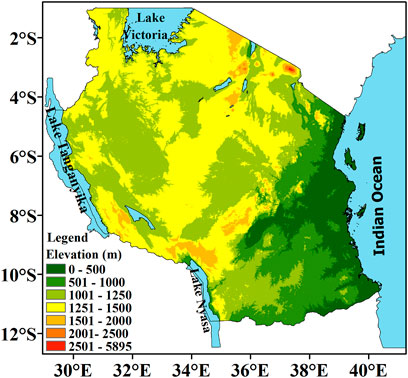- 1Collaborative Innovation Center on Forecast and Evaluation of Meteorological Disasters/Key Laboratory of Meteorological Disaster, Ministry of Education/International Joint Research Laboratory of Climate and Environment Change, Nanjing University of Information Science and Technology, Nanjing, China
- 2School of Atmospheric Sciences, Nanjing University of Information Science and Technology, Nanjing, China
- 3Department of Physics, University of Dar es Salaam, Dar es Salaam, Tanzania
This study presents the relationship between Tanzania short rain variability and the sea surface temperature (SST) over the Southern Oceans from 1950 to 2017. It is found that the warm SST anomalies to the east of Australia (EA-SST) and the southern Atlantic Ocean (SA-SST) are significantly negatively correlated with the OND rainfall throughout Tanzania, signifying that the warmer (cooler) than normal EA-SST and SA-SST tend to cause a suppressed (enhanced) OND rainfall in Tanzania. Further investigation indicates that the above-normal SA-SST anomalies are linked to the changes of Walker-type circulation over the Atlantic Ocean, with the low-level (upper-level) divergence (convergence) occurring over the study region, which suppresses the in-situ convection and hence decreases the rainfall over Tanzania. The above-normal SA-SST anomalies are associated with the upper-level wave patterns propagating from the southern Atlantic Ocean, resulting in the formation of cyclonic anomalies over the target region. The upper-level cyclonic anomalies formed favor the subsidence of airflows over Tanzania and hence reduce rainfall. The local moisture and dynamical conditions also support the atmospheric circulations observed, whereby warm EA-SST and SA-SST anomalies are associated with the westerly moisture flux over the Indian Ocean moving away from Tanzania and the descending motion over Tanzania. Hence, close monitoring of SST anomalies over these regions might be useful in updating OND rainfall seasonal forecasts in Tanzania.
Introduction
Extreme climate events like floods and droughts are regular over East Africa, including Tanzania, leading to great socio-economic impacts (Anande and Luhunga, 2019; Kimambo et al., 2019; Chang’a et al., 2020a; Mzava et al., 2020). Understanding the physical processes that cause such events can minimize the impacts. Also, understanding the temporal and spatial variations of rainfall over Tanzania and their relationship with physical factors are crucial in water resource planning, land use planning, agriculture, and irrigation. The seasonal movement of the Intertropical Convergence Zone (ITCZ) mainly influences the rainfall patterns over the East African region, leading to two rainy seasons during the October-December (OND) and the March-May (MAM) in the northern coastal and northeastern parts of Tanzania and a single rainy season starting from November to April in the central and southern areas of Tanzania. In the East African region, MAM rainfall is locally known as ‘long rain’ while OND rainfall is named as ‘short rain’ based on their contributions to the annual rainfall amount over the region, whereby MAM rainfall contributes more rainfall than OND rainfall. Recent studies have reported frequent floods in Tanzania during the OND rainfall season (Mbigi and Xiao, 2021b), while the MAM rainfall season reported experiencing a decadal decrease in the late 1990s (Makula and Zhou, 2021).
Tanzanian OND rainfall exhibits large interannual variations compared to MAM rainfall (Black et al., 2003). The potential roles of sea surface temperature (SST) over the tropical Indian Ocean, tropical Pacific Ocean and tropical Atlantic Ocean on the variability of OND rainfall over the study region have been explored in detail from past studies (e.g., Nicholson, 2015, 2017; Wenhaji Ndomeni et al., 2018). It is documented that OND rainfall over the target region is linked to the Indian Ocean Dipole (IOD), El Niño–Southern Oscillation (ENSO), Walker circulations over the Indian Ocean and Atlantic Oceans (Limbu and Guirong, 2019, 2020; Kavishe and Limbu, 2020; Ame et al., 2021; Mbigi and Xiao, 2021a, 2021b). Some previous studies investigated the physical mechanisms of individual effects of ENSO and IOD (e.g., Clark et al., 2003; Saji and Yamagata, 2003; Behera et al., 2005; Black, 2005; Bahaga et al., 2019; Chang’a et al., 2020b; Lüdecke et al., 2021), while others investigated the combined effects of ENSO and IOD on Tanzanian rainfall during OND season (e.g., Mbigi and Xiao, 2021b). Clark et al. (2003) found that ENSO is one of the forcing mechanisms of rainfall variability over some areas of the East African region. Besides, Black (2005) found that the relation between the OND rainfall over the East African region and ENSO reveals a dynamic connection between the IOD and ENSO. However, it was re-revealed that the pure ENSO influence is weaker in parts of East Africa (Saji and Yamagata, 2003; Bahaga et al., 2019). In contrast, some studies found that the IOD impact is more prominent over OND rainfall in Tanzania than ENSO (Behera et al., 2005; Lüdecke et al., 2021). In addition, it was reported that the 2019 extreme OND rainfall over East Africa was linked to the positive phase of the IOD, while that of 1997 was connected to the combined effects of positive IOD and El Niño (Chang’a et al., 2020). Ame et al. (2021) found that the combined effects of ENSO and IOD significantly impact the seasonal evolution of Tanzanian OND rainfall. Generally, El Nino (La Nina) events are linked to an increased (reduced) OND rainfall in Tanzania, and positive (negative) IOD events are connected to above (below) normal OND rainfall over the region (Nicholson, 2015, 2017; Wenhaji Ndomeni et al., 2018). Apart from ENSO and IOD events which link to the precipitation over the region, it was also reported that a change in the direction of the descending and ascending branches of the Walker circulation is related to rainfall variability over Tanzania, which occurs in linkage to tropical SST and convection anomalies (Limbu and Guirong, 2019, 2020).
In addition, a recent study by Mbigi and Xiao (2021a) reported the factors associated with the interannual and interdecadal variability of short rains in Tanzania, whereby at an interannual time scale, Tanzanian’s short rain variability is linked to IOD and ENSO, which are connected to changes in the atmospheric circulations over the western Indian Ocean. On the other hand, at the decadal time scale, it was reported that Tanzania’s short rain variability is related to the SST over the tropical central Indian Ocean and the Atlantic Ocean. Moreover, a study by Kebacho (2021b) examined how the interaction between the tropical eastern Pacific and Atlantic Oceans impacts extreme weather events over Tanzania, whereby a proposed Trans-Atlantic-Pacific Ocean Dipole index (TAPODI) was reported to significantly correlate with the short rains over Tanzania. The positive (negative) phase of the TAPODI is associated with the enhanced (suppressed) rainfall over Tanzania by affecting the low level and upper-level atmospheric circulations that modulate moisture supply over the target region.
Generally, from the literature, the influence of tropical equatorial SST over the Indian Ocean, Pacific Ocean, and the Atlantic Ocean on the OND rainfall variability in Tanzania has been discussed; however, the possible impact of SST over the Southern Oceans on the variability of OND rainfall in Tanzania has not been examined or explored in detail. Also, continuous studies are highly prioritized due to continuous and varying impacts resulting from climate change and the need to improve the forecasting accuracy of rainfall over the target region. Therefore, the present study investigates the Tanzania short rain variability and its relations to SST over the Southern Oceans. The finding of this paper is crucial to climate forecasters in understanding and predicting extreme events for decision-making while planning about adaptation and mitigation measures to cope with climate change and reduce socio-economic losses associated with extreme events in the region.
The remainder of this study is as follows. Section 2 describes the study area, data and methods. The distribution of the short rains in Tanzania is presented in Section 3, in which the associated atmospheric circulations are analyzed. The relationship between the SST over the Southern Oceans and Tanzania’s short rains, including the candidate physical mechanisms, are examined in Section 4. Finally, the conclusion is summarised in Section 5.
Study Area, Data, and Methods
Study Area
Tanzania is an equatorial tropical country located over eastern Africa within longitude 28°–42°E and latitude 12°–0°S (Figure 1). The region has complex topography ranging from low-lying areas to highlands. The topographical features range from the coastal plains to southern and northeastern highlands. The northeastern highlands region is where Mount Kilimanjaro is located, Africa’s highest point standing out at the altitude of 5895 m. Lakes surrounding Tanzania are Victoria, Tanganyika, and Nyasa. The Indian Ocean borders the eastern coast of Tanzania, as can be seen in Figure 1. These water bodies play an important role in supplying moisture over the target region.
The climatological distribution of OND rainfall in Tanzania (Figure 2) shows that there are more rains (more than 75 mm) in the western parts of the country, the Lake Victoria basin, followed by southern and eastern Tanzania. The central areas (semi-arid regions), southwestern highlands and the northeastern highlands of Tanzania record less amount of rainfall (less than 75 m). The presence of Lake Victoria and Lake Tanganyika aids in supplying moisture over northern and western Tanzania for rainfall formation. In addition, the western and Lake Victoria basin benefit from moisture supply from the Congo basin, attributed by the ITCZ’s movement, which favors the early onset of rainfall over these regions.
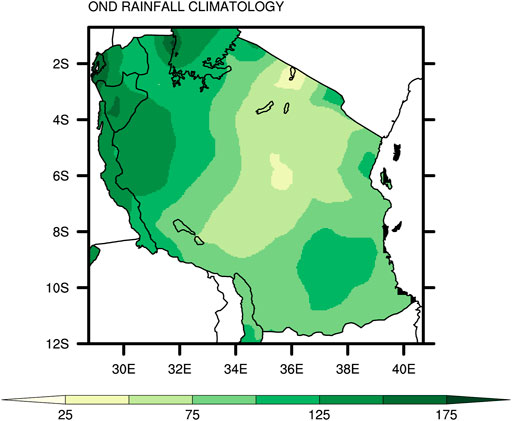
FIGURE 2. Map of the seasonal climatological (OND) distribution of precipitation (mm month−1) in Tanzania during 1950–2017.
Data and Methods
The present study covers a period from 1950 to 2017. The gridded monthly precipitation data with the horizontal resolution of 0.5° × 0.5° obtained from the Climatic Research Unit (CRU) at the University of East Anglia is utilized to analyze OND rainfall variability over Tanzania. The CRU precipitation dataset is version 4.04 (Harris et al., 2020). The sea surface temperature (SST) data with the resolution of 2° × 2° used is the monthly Extended Reconstructed SST version 5 (ERSSTv5) (Huang et al., 2017). Other datasets used in the present study include the monthly horizontal winds, specific humidity, surface pressure, geopotential height, velocity potential, and vertical velocity (Omega) at 2.5° × 2.5° provided by the National Centers for Environmental Prediction/National Center for Atmospheric Research (NCEP/NCAR) (Kalnay et al., 1996; Kistler et al., 2001).
This study employed the empirical orthogonal function (EOF) (Lorenz, 1956; Hannachi et al., 2007; Yosef et al., 2017; Chidean et al., 2020) to examine spatial modes (i.e., patterns) of OND rainfall variability at a spatial resolution of 0.5° × 0.5° and how they change with time during 1950–2017. The EOF is analyzed by calculating the eigenvalues and eigenvectors of a field’s spatially weighted anomaly covariance matrix. Some past studies have used this technique to investigate how precipitation varies over East Africa, including Tanzania (e.g., Smith and Semazzi, 2014; Limbu and Guirong, 2020). Moreover, correlation and regression analyses were also employed in the present study, and the Student’s t-test (Goulden, 1956) was used to assess the statistical significance at both 95 and 99% confidence levels.
This study focuses on the SST anomalies in the Southern Oceans. The SST anomalies averaged to the east of Australia (EA-SST, 16°–30°S, 165E°–155°W) and the southern Atlantic Ocean (SA-SST, 37°–54°S, 20°–49°W) are defined as the EA-SST index and SA-SST index, respectively. After analyzing the relationship between OND rainfall over Tanzania and SST anomalies to the east of Australia and the southern Atlantic Ocean, we examined the possible physical mechanisms linked to these relationships. The combined effect of SST anomalies in these two regions on Tanzania short rain was further analyzed using the synergic index, constructed by adding the normalized EA-SST and SA-SST indices. The present study also utilized the Niño3.4 index (ENSO) and IOD index to examine their relationships to OND rainfall in Tanzania. The Niño3.4 index is calculated as an area-averaging of SST over the tropical eastern Pacific Ocean (5
EOF of OND Rainfall in Tanzania
Figure 3 depicts the spatial distribution of short rains anomalies in Tanzania and their corresponding principal components for the first three modes of EOF. The first three modes of short rains in Tanzania explain 72.0, 8.1, and 4.7%, respectively, making 84.8% of the total variance. The first EOF mode (EOF1) features a homogeneous rainfall pattern throughout the country, with the maximum positive loading over northeastern and eastern Tanzania. The second EOF mode (EOF2) displays a dipole pattern with the positive loading over northern Tanzania and the negative loading over the southern part of Tanzania. Likewise, the third EOF mode (EOF3) shows a dipole pattern with the negative loading over eastern Tanzania and the positive loading over the rest parts of Tanzania. The EOF1 is statistically significant and independent from the other modes regarding the North’s criteria (North et al., 1982). Thus, the present study focused on the EOF1 mode of MAM rainfall in Tanzania. Its corresponding principal component (PC1) exhibits both interannual and interdecadal variability.
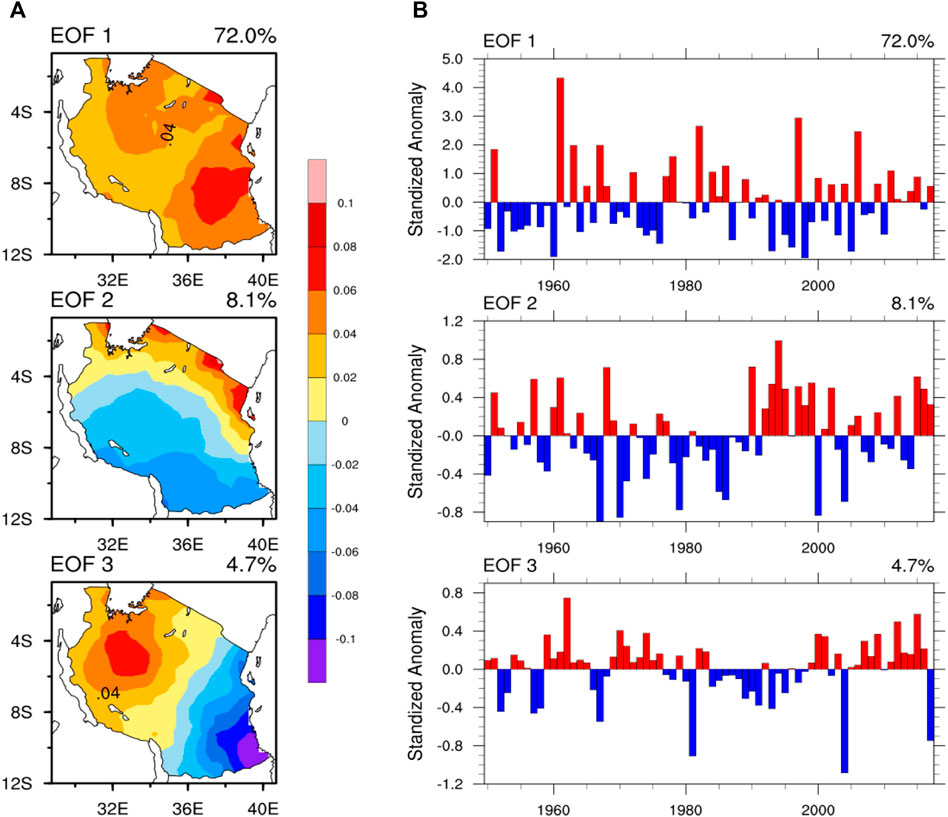
FIGURE 3. (A) Spatial pattern (mm month−1) and (B) Principal components (PCs) of the first three EOF modes of OND rainfall in Tanzania during 1950–2017.
To reveal the atmospheric circulations associated with the variability of short rains in Tanzania, we analyzed the regression of horizontal winds against the PC1. As shown in Figure 4A, an enhancement of OND rainfall in Tanzania is associated with a convergence of westerlies and enhanced easterlies over the western Indian Ocean (eastern Tanzania) in the lower troposphere. Accordingly, anomalous low-level easterlies transport water vapor from the Indian Ocean to the study domain, which is conducive to the increase of rainfall in situ. In the upper troposphere (Figure 4B), a divergence is observed over the central Indian Ocean, with prevalent easterly anomalies over Tanzania and the western Indian Ocean, concurrent with the westerly anomalies over the eastern Indian Ocean favoring the uplift over the study domain and thus enhancing rainfall. The anomalous pattern in the upper level indicates the rising limb of the Walker-type circulation over East Africa and the western Indian Ocean.
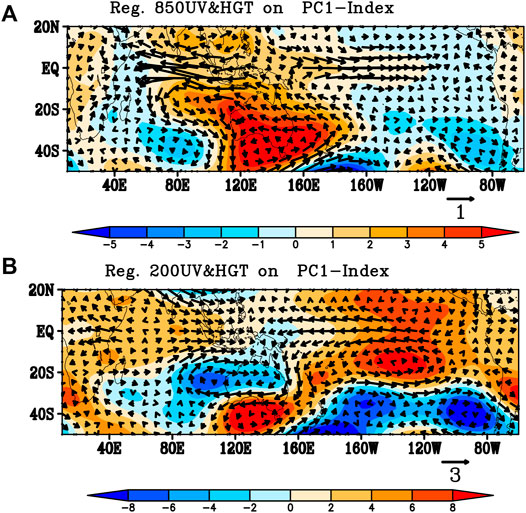
FIGURE 4. Regressions of (A) 850 hPa horizontal winds (vectors; m s−1) and geopotential height (shading; m), (B) 200 hPa horizontal winds (vectors; m s−1), and geopotential height (shading; m) against the PC1 during OND season for 1950–2017.
Relationship Between SST Over the Southern Oceans and Tanzania Rainfall
The correlation between the OND SST anomalies and PC1 during 1950–2017 (Figure 5A) was analyzed to determine the key regions in the Southern Oceans where the SST variability is connected to short rains in Tanzania. The result shows that the PC1 is positively and significantly correlated with the SST anomalies to the western Indian Ocean and negatively correlated with the southeastern Indian Ocean, exhibiting a dipole pattern referred to as the IOD, as documented by Saji et al. (1999). Furthermore, the PC1 is also positively and significantly correlated with the SST anomalies over the tropical central-eastern Pacific Ocean, implying that the rainfall over the region is also influenced by the ENSO. In addition, the PC1 is negatively and significantly correlated with the SST anomalies to the east of Australia and the southern Atlantic Ocean. We further analyzed the correlation coefficients between the PC1 and the SST indices over the above regions. It is found that the IOD (Nino3.4) index correlation coefficient with the PC1 is 0.73 (0.43), statistically significant at a 99% confidence level. These findings are similar to previous studies carried out over the region, showing that short rain variability in Tanzania is linked to IOD events and ENSO events, whereby positive (negative) IOD events are associated with above (below) normal rainfall (Limbu and Guirong, 2019; Kavishe and Limbu, 2020; Ame et al., 2021; Mbigi and Xiao, 2021a, 2021b) and El Nino (La Nina) events are connected to enhanced (suppressed) rainfall over the target region (Mbigi and Xiao, 2021b). The correlation coefficient between the PC1 and the EA-SST (SA-SST) index (Figure 5B) is −0.52 (−0.34), also statistically significant at a 99% confidence level. It is known that the ENSO signal can influence the Southern Ocean SST (e.g., Li, 2000; Ciasto and England, 2011; Yeo and Kim, 2015); due to this, the partial correlations between the PC1 and the EA-SST/SA-SST index while controlling for the effect of ENSO signal were performed to determine whether the correlations of the PC1 with the two regional SSTs are dependent on the ENSO signal. The result shows that the EA-SST (SA-SST) index partial correlation coefficient with the PC1 is −0.34 (−0.29), significant at a 99% (95%) confidence level. This finding implies that there is a substantial relationship between EA-SST/SA-SST anomalies with the Tanzania short rain in the absence of the ENSO signal.
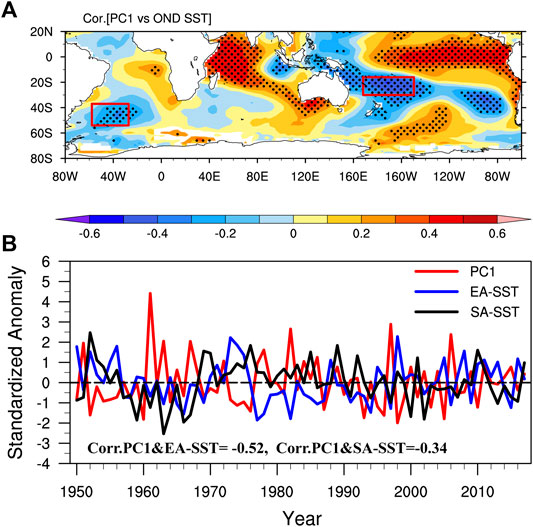
FIGURE 5. (A) Spatial distribution of correlations between PC1 and Southern Ocean Sea Surface Temperature for OND season during 1950–2017. Regions above the 95% Confidence level are dotted. (B) Normalized time series of the PC1 of OND rainfall over Tanzania (PC1) and SST anomalies indices averaged over EA-SST (16°–30°S, 165E°–155°W) and SA-SST (37°–54°S, 20°–49°W) during 1950–2017.
The physical mechanisms linked to the influence of IOD/ENSO on the variability of short rain in Tanzania have been examined in detail by previous studies (Limbu and Guirong, 2019; Kavishe and Limbu, 2020; Ame et al., 2021; Mbigi and Xiao, 2021a, 2021b). However, the physical mechanisms related to the influence of SST anomalies in the Southern Oceans on the variability of short rain in Tanzania have not been analyzed. Therefore, in the following, we focus on the possible physical mechanisms underlying the relationship between OND rainfall over Tanzania and SST anomalies to the east of Australia and the southern Atlantic Ocean.
Influence of SST Anomalies to East of Australia
The relationship between the EA-SST index and OND rainfall was analyzed to highlight the linkage of SST anomalies to the east of Australia and OND rainfall variability in Tanzania. As seen in Figure 6, the EA-SST index is significantly negatively correlated with OND precipitation throughout Tanzania at a 99% confidence level. The bimodal regions (i.e., northeastern and eastern Tanzania) display the highest correlations ranging from -0.45 to -0.55, while the rest parts of the country (unimodal areas) exhibit correlations ranging from −0.35 to −0.45, signifying that the EA-SST has more influences on rainfall over the northeastern and eastern regions of Tanzania compared to other parts of the country. Generally, the negative SST anomalies to the east of Australia are related to a substantial increase in OND precipitation over Tanzania. In contrast, positive SST anomalies to the east of Australia are connected to a considerable decrease in OND rainfall over Tanzania.
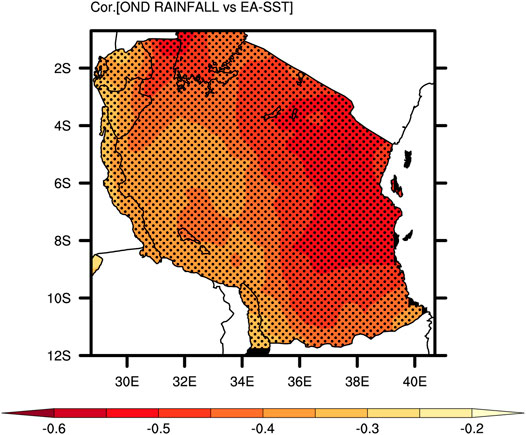
FIGURE 6. Correlation map of OND rainfall in Tanzania with OND EA-SST index during 1950–2017. Regions above the 99% confidence level are dotted.
Figure 7 shows the 850-hPa, and 200-hPa horizontal winds regressed onto the EA-SST index. It can be seen in Figure 7A that the positive SST anomalies to east of Australia are associated with easterly anomalies over the western Indian Ocean and Tanzania and westerly anomalies over the eastern Indian Ocean, favoring low-level divergence over the study region and the Indian Ocean. According to Figure 4A, such a circulation anomaly corresponds to the unfavorable atmospheric situation for precipitation in Tanzania by transporting moisture away from the study area. Furthermore, as shown in Figure 7B, positive SST anomalies to east of Australia are associated with convergence in the upper troposphere over the western Indian Ocean. The upper-level convergence observed is beneficial for the subsidence of airflows over Tanzania, contributing to suppressed OND precipitation in the target region. The low-level equatorial westerlies over the central and eastern Indian Ocean are connected to droughts over the study domain, as also documented by Nicholson (2016), Hastenrath et al. (2010), and Kebacho (2021a) in past studies.
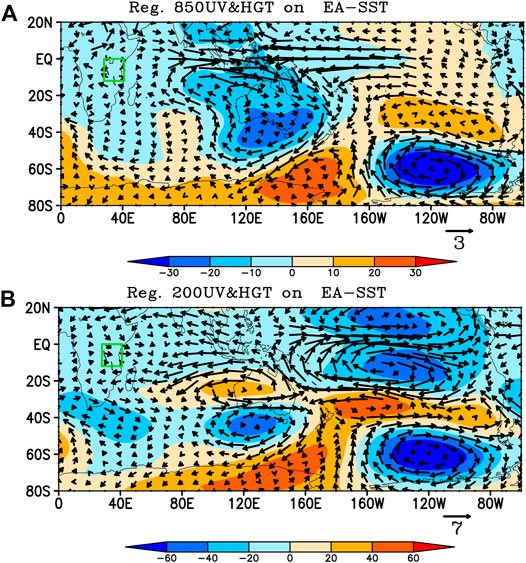
FIGURE 7. Regressions of (A) 850 hPa horizontal winds (vectors; m s−1) and geopotential height (shading; m), (B) 200 hPa horizontal winds (vectors; m s−1), and geopotential height (shading; m) against the EA-SST during OND season for 1950–2017.
The atmospheric circulations in Figure 7 imply the changes in Walker-type circulation over the Indian Ocean; therefore, in Figure 8, we regressed velocity potential and divergent wind anomalies against the EA-SST index to reveal Walker circulation changes. Negative velocity potential anomalies and wind divergence are observed in the lower troposphere throughout the region centred at 40°E and 5°S (Figure 8A). Correspondingly, positive velocity potential and wind convergence in the upper troposphere are observed (Figure 8B). The observed positive velocity potential and wind convergence in the upper levels enhance the descending limb of Walker circulation over the western Indian Ocean. The sinking branch of the Walker circulation over the study area and the western Indian Ocean suppresses convection, hence the decreased rainfall over the target region. In opposite, the negative SST anomalies to the east of Australia are linked to the ascending limb of the Walker circulation over the western Indian Ocean and Tanzania, which favors enhanced precipitation. The results agree with previous studies, which reported that a change in the direction of the descending and ascending branch of the Walker circulation is associated with rainfall variability over Tanzania, which occurs in linkage to tropical SST and convection anomalies (Limbu and Guirong, 2019, 2020). But also, the negative SST anomalies to the east of Australia are linked to the low-level equatorial easterlies over the central Indian Ocean connected to above normal rainfall over the study domain, as also reported by Nicholson (2016), Hastenrath et al. (2010), and Kebacho (2021a) in past studies.
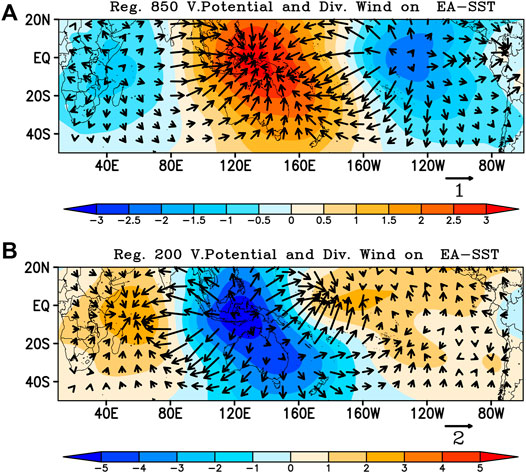
FIGURE 8. Regressions of (A) 850 hPa velocity potential (shading; 106 m2 s−1) and divergent winds (vectors; m s−1), (B) 200 hPa velocity potential (shading; 106 m2 s−1) and divergent winds (vectors; m s−1), against the EA-SST index during OND season for 1950–2017.
The unfavorable atmospheric situation for precipitation in Tanzania by transporting moisture away from the study area, as seen in Figure 7, can be further demonstrated by Figure 9A, which displays the anomalies of vertically integrated water vapor transport flux regressed onto the EA-SST index. This figure exhibits anomalous westerly moisture fluxes propagating away from Tanzania, thereby resulting in less water vapor over the region and, hence, decreasing OND rainfall over Tanzania. Moreover, the water vapor flux divergence is also observed over Tanzania to support the decrease of OND rainfall in Tanzania associated with the EA-SST. As observed from the regression result of Omega against the EA-SST index (Figure 9B), descending motion is predominant throughout Tanzania, with the significantly suppressed convection (descending motion) over eastern Tanzania and the Indian Ocean, which provides unfavorable dynamics for the occurrence of local precipitation. The suppressed convection over Tanzania and the Indian Ocean also confirms the substantial correlation between SST anomalies to the east of Australia and OND rainfall in Tanzania.
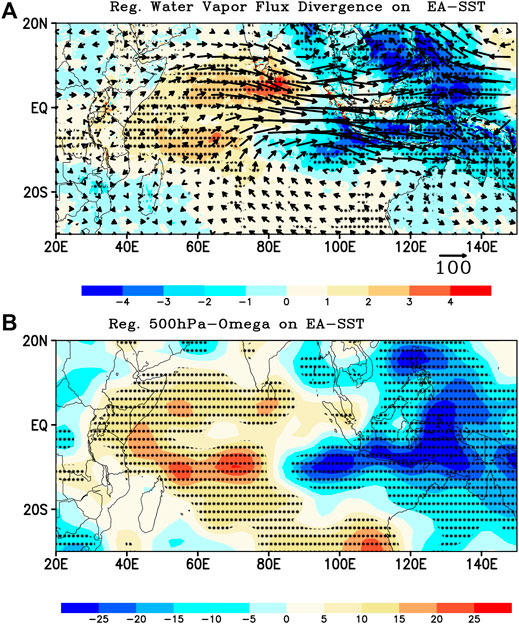
FIGURE 9. Regressions of (A) divergence (10−5 kg s−1 m−2) of water vapor transport flux integrated from surface to 300 hPa (B) 500 hPa Omega (10−3 pa s−1) against the EA-SST index during OND season for 1950–2017. Regions above the 95% confidence level are dotted.
Based on the above findings, it can be concluded that the SST anomalies to the east of Australia play an important role in influencing the variability of OND rainfall in Tanzania through modulating the moisture (Figure 9A) and dynamic conditions (Figure 9B) over the target region. Thus, the positive SST anomalies to the east of Australia are associated with unfavorable conditions for the formation of precipitation and thus decrease the precipitation in Tanzania, whereby the situation is reversed for the negative SST anomalies to the east of Australia, which provides conducive conditions for the increase of rainfall over Tanzania.
Influence of SST Anomalies Over the Southern Atlantic Ocean
The relationship between the SA-SST index and short rains over Tanzania was also analyzed to highlight the association between SST anomalies over the southern Atlantic Ocean and OND rainfall in Tanzania. Figure 10 shows that the SA-SST index significantly negatively correlates with OND rainfall over almost the target region. The considerable correlations over Tanzania imply that the OND precipitation over the stated region tends to decrease if the SST is above the normal over the southern Atlantic Ocean and vice versa.
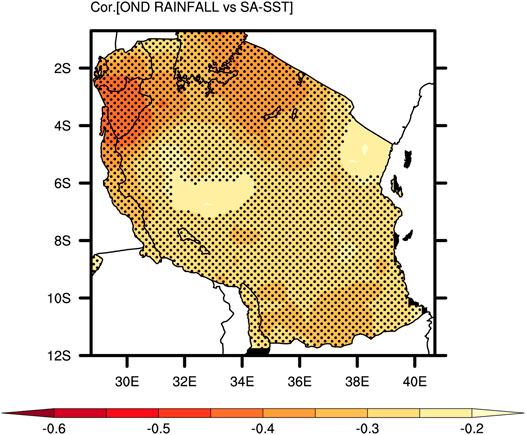
FIGURE 10. Correlation map of OND rainfall in Tanzania with OND SA-SST index during 1950–2017. Regions above the 95% confidence level are dotted.
Having observed how the SA-SST index spatially correlates with rainfall over Tanzania, then we analyzed the atmospheric circulations connected to the SA-SST index. Figure 11 shows the 850-hPa, and 200-hPa horizontal winds regressed onto the SA-SST index. Associated with the warm SST over the southern Atlantic Ocean, divergence appears in the lower troposphere of Tanzania and the Indian Ocean (Figure 11A), and convergence prevails in the upper troposphere of Tanzania and the western Indian Ocean (Figure 11B), corresponding to the atmospheric situation unfavorable for the occurrence of precipitation over Tanzania (Figure 4). Moreover, the atmospheric teleconnection process accomplished the influence of SA-SST anomalies over the southern Atlantic Ocean on the atmospheric circulations over the region, as can be seen in Figure 11B, whereby wave trains patterns, with the anticyclonic-cyclonic-anticyclonic anomalies, propagate from the south Atlantic Ocean to the target region. Therefore, the SA-SST anomalies over the Southern Ocean can bring about variation in atmospheric circulations over Tanzania and the western Indian Ocean through this teleconnection. The observed low-level equatorial westerlies over the central Indian Ocean are linked to droughts over the study region, as previously also reported by Nicholson (2016), Hastenrath et al. (2010), and Kebacho (2021a).
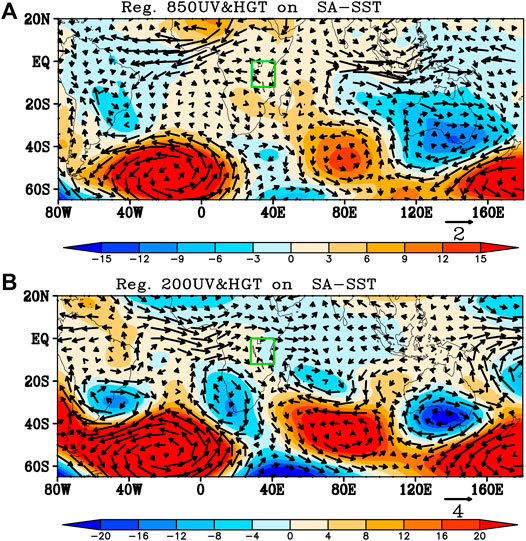
FIGURE 11. Regressions of (A) 850 hPa horizontal winds (vectors; m s−1) and geopotential height (shading; m), (B) 200 hPa horizontal winds (vectors; m s−1) and geopotential height (shading; m) against the SA-index during OND season for 1950–2017.
The circulation anomalies observed in Figure 11 indicate that the positive SST anomalies over the southern Atlantic Ocean are associated with the changes in Walker-type circulations over the Atlantic Ocean and the Indian Ocean, in which low-level convergence (divergence) and upper-level divergence (convergence) over the tropical Atlantic Ocean (Indian Ocean) are observed. To further reveal the connection between SA-SST anomalies and the change in Walker-type circulation, we regressed the velocity potential and divergent wind anomalies against the SA-SST index. It is observed that warm SA-SST anomalies are associated with the negative velocity potential anomalies and wind divergence in the lower troposphere throughout the study region centred at the eastern coast of Somalia (Figure 12A). Correspondingly, positive velocity potential and wind convergence in the upper troposphere are observed (Figure 12B). The observed positive velocity potential and wind convergence in the upper levels enhance the descending limb of both Atlantic Walker circulation and Indian Walker circulation over the western Indian Ocean and Tanzania. The sinking branch of the Walker circulations over the study area and the western Indian Ocean suppresses convection, hence the decreased rainfall over the target region. On the contrary, the negative SST anomalies over the southern Atlantic Ocean are related to the ascending limbs of the Atlantic Ocean Walker circulation and Indian Ocean Walker circulation over the western Indian Ocean and Tanzania, which favor enhanced precipitation. The Walker circulation over the Atlantic ocean and the Walker circulation over the Indian Ocean, linked to tropical SST and convection anomalies, have potential impacts on rainfall variability over Tanzania (Limbu and Guirong, 2019, 2020).
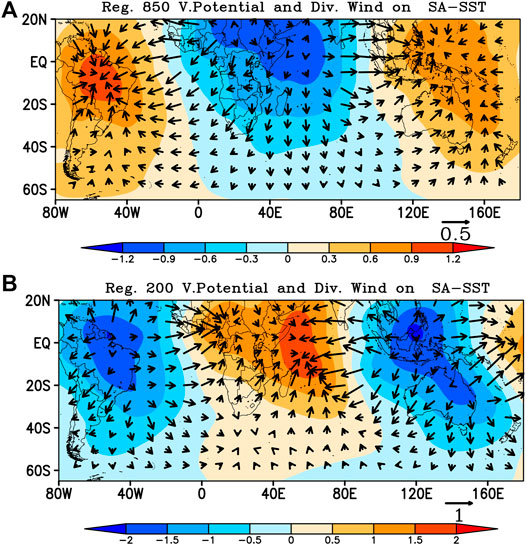
FIGURE 12. Regressions of (A) 850 hPa velocity potential (shading; 106 m2 s−1) and divergent winds (vectors; m s−1), (B) 200 hPa velocity potential (shading; 106 m2 s−1) and divergent winds (vectors; m s−1), against the SA index during OND season for 1950–2017.
The atmospheric circulation anomalies in the lower and upper troposphere observed in Figures 11,12 impact the OND rainfall by influencing Tanzania’s moisture and dynamic conditions. Similarly, associated with the warm SA-SST anomalies are the moisture flux outflow over Tanzania with enhanced westerly moisture fluxes over the Indian Ocean (Figure 13A). This anomalous pattern signifies the weakening of the easterly moisture flux from the Indian Ocean, which is important for wet conditions over Tanzania. Hence, the water vapor supply to Tanzania is suppressed. Besides, as shown in Figure 13B, the descending motion is observed over Tanzania and the Indian Ocean, which provides unfavorable dynamic conditions for precipitation formation. As a result, the OND rainfall decreases in Tanzania.
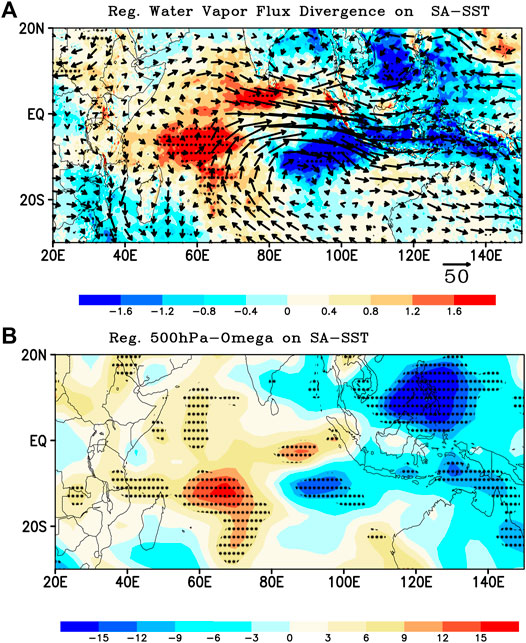
FIGURE 13. Regressions of (A) divergence (10−5 kg s−1 m−2) of water vapor transport flux integrated from surface to 300 hPa (B) 500 hPa Omega (10−3 pa s−1) against the SA-SST index during OND season for 1950–2017. Regions above the 95% confidence level are dotted.
In summary, the warm SST anomalies over the southern Atlantic Ocean play an important role in impacting the OND rainfall over Tanzania through a teleconnection process by modulating the upper-level wave trains over the southern Atlantic Ocean, characterized by anticyclonic-cyclonic-anticyclonic-cyclonic anomalies propagating to the target region. Consequently, the upper-level cyclic anomalies formed over the study area modulate the moisture (Figure 13A) and dynamic conditions (Figure 13B) over the target region. Thus, the positive SST anomalies over the southern Atlantic Ocean are associated with unfavorable conditions for precipitation formation and thus decrease the precipitation in Tanzania, whereby the situation is reversed for the negative SST anomalies over the southern Atlantic Ocean, which provides conducive conditions for the increase of rainfall over Tanzania.
Summary and Conclusion
This study presents the Tanzania short rain variability and its relations to the SST over the Southern Oceans. It is found that the warm SST anomalies to the east of Australia are significantly negatively correlated with the short rains throughout Tanzania. When the SST anomalies to the east of Australia are warmer (cooler) than normal, the short rains tend to decrease (increase) over Tanzania. The warmer EA-SST anomalies impact Tanzania’s rainfall by modulating moisture and dynamic conditions. The positive EA-SST anomalies are linked to the enhanced divergence in the lower troposphere and the enhanced convergence in the upper troposphere over Tanzania and the western Indian Ocean, which signifies the sinking of the Walker-type circulations over the Indian Ocean. These circulations anomalies are unfavorable for the occurrence of rainfall over the region. In addition, atmospheric circulations related to the positive EA-SST anomalies, associated with reduced precipitation over Tanzania, are supported by the westerly moisture flux over the Indian Ocean moving away from Tanzania (i.e., moisture divergence) and the descending motion over the target region.
Likewise, the above-normal SST anomalies over the southern Atlantic Ocean are also related to decreased OND rainfall over Tanzania. The above-normal SA-SST anomalies are linked to the changes of Walker-type circulation over the Atlantic Ocean, with the low-level (upper-level) divergence (convergence) occurring over the study domain. This indicates the sinking limb of the Atlantic Ocean Walker circulation over the study domain and the western Indian Ocean, which suppresses the in-situ convection and hence decreases the rainfall over Tanzania. Moreover, the above-normal SST anomalies over the southern Atlantic Ocean are associated with the upper-level wave patterns featured by alternative anticyclonic and cyclonic anomalies propagating from the southern Atlantic toward the target region and the western Indian Ocean. The upper-level cyclonic anomalies formed favor the subsidence of airflows over Tanzania and hence reduced rainfall. The local moisture and dynamical conditions also support the atmospheric circulations observed, whereby warm SA-SST anomalies are associated with the westerly moisture flux over the Indian Ocean moving away from Tanzania (moisture divergence) and the descending motion over Tanzania. On the contrary, the negative SST anomalies over the southern Atlantic Ocean are related to the ascending limbs of the Atlantic Ocean Walker circulation and Indian Ocean Walker circulation over the western Indian Ocean and Tanzania, enhanced ascending motions, easterly moisture flux from the Indian Ocean and moisture convergence over Tanzania which favor enhanced precipitation.
The schematic of the processes that potentially explain the influence of the SST anomalies over the Southern Oceans in warmer and cooler phases is summarized in Figure 14. Interestingly, if we construct a synergic index by adding the normalized EA-SST and SA-SST to reflect the combined effect of SST anomalies to the east of Australia and the southern Atlantic Ocean; it is found that this index is also significantly correlated to the PC1 with a correlation coefficient of −0.55 (above the 99% confidence level). Spatially, the regions with the largest correlations are located in the north and eastern Tanzania (Figure 15), which is similar to the EOF1 pattern and indicates that the combined effect of SST anomalies in these two regions may intensify the impact on precipitation in Tanzania.
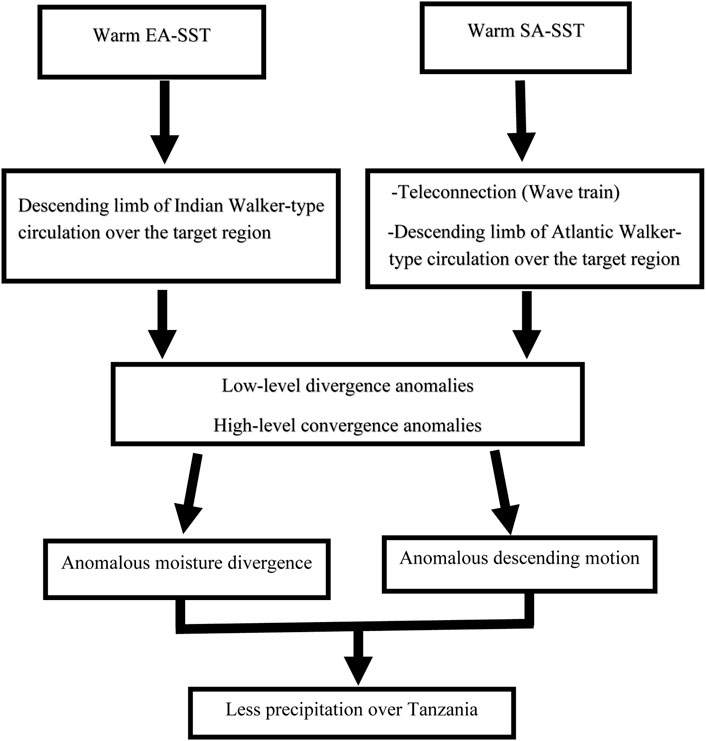
FIGURE 14. Schematic summary of the process for the impact of warm EA-SST and SA-SST on OND precipitation in Tanzania.
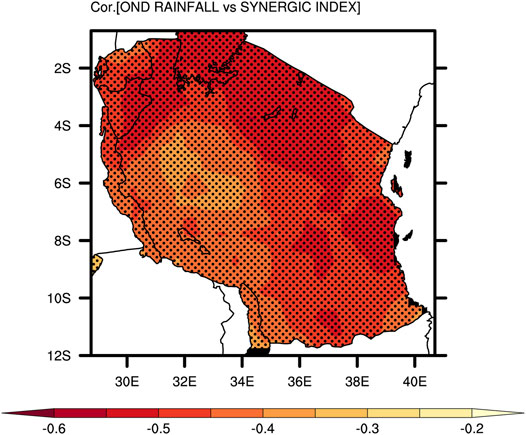
FIGURE 15. Correlation map of OND rainfall in Tanzania with the synergic index constructed by adding the normalized EA-SST and SA-SST during 1950–2017. Regions above the 99% confidence level are dotted.
In general, based on the statistical analysis, our study highlights that the above-normal (below-normal) SST anomalies to the east of Australia and the southern Atlantic Ocean are related to the suppressed (enhanced) rainfall over Tanzania during the short rain season. Hence, close monitoring of SST anomalies over these regions might be useful in updating OND rainfall seasonal forecast in Tanzania, which helps to reduce socio-economic impacts. However, numerical simulation experiments are needed to confirm the proposed physical mechanisms for future study since the proposed physical mechanisms are based only on statistical analyses (observational diagnoses). Not only that, but also to determine the individual contributions of SST anomalies over different key regions in the Southern Oceans, the tropical Indian Ocean, the tropical Atlantic Ocean, and the tropical Pacific Ocean in influencing the variability of short rains in Tanzania.
Data Availability Statement
The datasets utilized in this study can be found in online repositories. The names of the repository/repositories and links can be found below: The Climatic Research Unit (CRU) at the University of East Anglia (https://data.ceda.ac.uk/badc/cru/data/cru_ts/cru_ts_4.04/data/pre). Monthly Extended Reconstructed SST version 5 (https://iridl.ldeo.columbia.edu/SOURCES/.NOAA/.NCDC/.ERSST/.version5/.sst/?Set-Language=en), and the National Centers for Environmental Prediction/National Center for Atmospheric Research, websites (http://iridl.ldeo.columbia.edu/SOURCES/.NOAA/.NCEP-NCAR/.CDAS-1/.MONTHLY/.Intrinsic/.PressureLevel/) or (https://psl.noaa.gov/data/gridded/data.ncep.reanalysis.derived.html).
Author Contributions
EM: Conceptualization, Methodology, Software, Data collection, Formal Analysis and visualization, Scientific interpretations, Writing—Original Draft, Writing- Review and Editing. BZ: Conceptualization, Scientific interpretations, Writing—Review and Editing, Resources and Supervision.
Funding
This research was jointly supported by the National Key Research and Development Program of China (2017YFA0605004) and the Program for Distinguished Professor of Jiangsu.
Conflict of Interest
The authors declare that the research was conducted in the absence of any commercial or financial relationships that could be construed as a potential conflict of interest.
Publisher’s Note
All claims expressed in this article are solely those of the authors and do not necessarily represent those of their affiliated organizations, or those of the publisher, the editors and the reviewers. Any product that may be evaluated in this article, or claim that may be made by its manufacturer, is not guaranteed or endorsed by the publisher.
Acknowledgments
Special thanks to Nanjing University of Information Science & Technology for providing a conducive research environment. High gratitude towards the data centers, CRU TS4.03, NOAA, and NCEP/NCAR for providing the datasets employed in the study. The lead author is grateful to the Chinese Scholarship Council (CSC) for the financial support.
References
Ame, H. K., Kijazi, A. L., Changa, L. B., Mafuru, K. B., Ngwali, M. K., Faki, M. M., et al. (2021). Rainfall Variability over Tanzania during October to December and its Association with Sea Surface Temperature (SST). Acs 11 (2), 324–341. doi:10.4236/acs.2021.112019
Anande, D. M., and Luhunga, P. M. (2019). Assessment of Socio-Economic Impacts of the December 2011 Flood Event in Dar Es Salaam, Tanzania. Acs 09 (3), 421–437. doi:10.4236/acs.2019.93029
Bahaga, T. K., Fink, A. H., and Knippertz, P. (2019). Revisiting Interannual to Decadal Teleconnections Influencing Seasonal Rainfall in the Greater Horn of Africa during the 20th Century. Int. J. Climatol. 39 (5), 2765–2785. doi:10.1002/joc.5986
Behera, S. K., Luo, J.-J., Masson, S., Delecluse, P., Gualdi, S., Navarra, A., et al. (2005). Paramount Impact of the Indian Ocean Dipole on the East African Short Rains: A CGCM Study. J. Clim. 18 (21), 4514–4530. doi:10.1175/JCLI3541.1
Black, E., Slingo, J., and Sperber, K. R. (2003). An Observational Study of the Relationship between Excessively Strong Short Rains in Coastal East Africa and Indian Ocean SST. Mon. Wea. Rev. 131 (1), 74–94. doi:10.1175/1520-0493(2003)131<0074:aosotr>2.0.co;2
Black, E. (2005). The Relationship between Indian Ocean Sea-Surface Temperature and East African Rainfall. Phil. Trans. R. Soc. A 363 (1826), 43–47. doi:10.1098/rsta.2004.1474
Chang’a, L. B., Kijazi, A. L., Mafuru, K. B., Kondowe, A. L., Osima, S. E., Mtongori, H. I., et al. (2020a). Assessment of the Evolution and Socio-Economic Impacts of Extreme Rainfall Events in October 2019 over the East Africa. Acs 10 (3), 319–338. doi:10.4236/acs.2020.103018
Chang’a, L. B., Kijazi, A. L., Mafuru, K. B., Nying’uro, P. A., Ssemujju, M., Deus, B., et al. (2020b). Understanding the Evolution and Socio-Economic Impacts of the Extreme Rainfall Events in March-May 2017 to 2020 in East Africa. AcsClim.Sci. 10 (4), 553–572. doi:10.4236/acs.2020.104029
Chidean, M. I., Caamaño, A. J., Casanova-Mateo, C., Ramiro-Bargueño, J., and Salcedo-Sanz, S. (2020). Spatio-temporal Climate Regionalization Using a Self-Organized Clustering Approach. Theor. Appl. Climatol. 140 (3–4), 927–949. doi:10.1007/s00704-019-03082-6
Ciasto, L. M., and England, M. H. (2011). Observed ENSO Teleconnections to Southern Ocean SST Anomalies Diagnosed from a Surface Mixed Layer Heat Budget. Geophys. Res. Lett. 38 (9), 2011GL046895. doi:10.1029/2011GL046895
Clark, C. O., Webster, P. J., and Cole, J. E. (2003). Interdecadal Variability of the Relationship between the Indian Ocean Zonal Mode and East African Coastal Rainfall Anomalies. J. Clim. 16 (3), 5482–5554. doi:10.1175/1520-0442(2003)016<0548:IVOTRB>2.0.CO10.1175/1520-0442(2003)016<0548:ivotrb>2.0.co;2
Hannachi, A., Jolliffe, I. T., and Stephenson, D. B. (2007). Empirical Orthogonal Functions and Related Techniques in Atmospheric Science: A Review. Int. J. Climatol. 27 (9), 1119–1152. doi:10.1002/joc.1499
Harris, I., Osborn, T. J., Jones, P., and Lister, D. (2020). Version 4 of the CRU TS Monthly High-Resolution Gridded Multivariate Climate Dataset. Sci. Data. 7 (1), 1–18. doi:10.1038/s41597-020-0453-3
Hastenrath, S., Polzin, D., and Mutai, C. (2010). Diagnosing the Droughts and Floods in Equatorial East Africa during Boreal Autumn 2005-08. J. Clim. 23 (3), 813–817. doi:10.1175/2009JCLI3094.1
Huang, B., Thorne, P. W., Banzon, V. F., Boyer, T., Chepurin, G., Lawrimore, J. H., et al. (2017). Extended Reconstructed Sea Surface Temperature, Version 5 (ERSSTv5): Upgrades, Validations, and Intercomparisons. J. Clim. 30 (20), 8179–8205. doi:10.1175/JCLI-D-16-0836.1
Kalnay, E., Kanamitsu, M., Kistler, R., Collins, W., Deaven, D., Gandin, L., et al. (1996). The NCEP/NCAR 40-Year Reanalysis Project. Bull. Amer. Meteor. Soc. 77 (3), 437–471. doi:10.1175/1520-0477(1996)077%3C0437:TNYRP%3E2.0
Kavishe, G. M., and Limbu, P. T. S. (2020). Variation of October to December Rainfall in Tanzania and its Association with Sea Surface Temperature. Arab. J. Geosci. 13 (13), 534. doi:10.1007/s12517-020-05535-z
Kebacho, L. L. (2021a). Anomalous Circulation Patterns Associated with 2011 Heavy Rainfall over Northern Tanzania. Nat. Hazards 109 (3), 2295–2312. doi:10.1007/s11069-021-04920-5
Kebacho, L. L. (2021b). Tanzania Short Rains and its Relations to Trans‐Atlantic‐Pacific Ocean Dipole‐like Pattern. Intl J. Climatol. doi:10.1002/joc.7496
Kimambo, O. N., Chikoore, H., and Gumbo, J. R. (2019). Understanding the Effects of Changing Weather: A Case of Flash Flood in Morogoro on January 11, 2018. Adv. Meteorology 2019, 1–11. doi:10.1155/2019/8505903
Kistler, R., Collins, W., Saha, S., White, G., Woollen, J., Kalnay, E., et al. (2001). The NCEP-NCAR 50-Year Reanalysis: Monthly Means CD-ROM and Documentation. Bull. Amer. Meteor. Soc. 82 (2), 247–267. doi:10.1175/1520-0477(2001)082<0247:tnnyrm>2.3.co;2
Li, Z. X. (2000). Influence of Tropical Pacific El Niño on the SST of the Southern Ocean through Atmospheric Bridge. Geophys. Res. Lett. 27 (21), 3505–3508. doi:10.1029/1999GL011182
Limbu, P. T. S., and Guirong, T. (2020). Influence of the Tropical Atlantic Ocean and its Walker Circulation Cell on October-December Rainfall Variability over Tanzania. Int. J. Climatol. 40 (13), 5767–5782. doi:10.1002/joc.6550
Limbu, P. T. S., and Tan, G. (2019). Relationship between the October-December Rainfall in Tanzania and the Walker Circulation Cell over the Indian Ocean. metz 28 (6), 453–469. doi:10.1127/metz/2019/0939
Lorenz, E. N. (1956). Empirical Orthogonal Functions and Statistical Weather Prediction. Statistical Forecast Project Report 1. Massachusetts: Cambridge, 49.
Lüdecke, H.-J., Müller-Plath, G., Wallace, M. G., and Lüning, S. (2021). Decadal and Multidecadal Natural Variability of African Rainfall. J. Hydrology Regional Stud. 34, 100795. doi:10.1016/j.ejrh.2021.100795
Makula, E. K., and Zhou, B. (2021). Changes in March to May Rainfall over Tanzania during 1978-2017. Int. J. Climatol. 41 (12), 5663–5675. doi:10.1002/joc.7146
Mbigi, D., and Xiao, Z. (2021a). Analysis of Rainfall Variability for the October to December over Tanzania on Different Timescales during 1951-2015. Int. J. Climatol. 41 (14), 6183–6204. doi:10.1002/joc.7173
Mbigi, D., and Xiao, Z. (2021b). Tanzanian Rainfall Responses to El Niño and Positive Indian Ocean Dipole Events during 1951-2015. Atmos. Ocean. Sci. Lett. 14 (6), 100093. doi:10.1016/j.aosl.2021.100093
Mzava, P., Valimba, P., and Nobert, J. (2020). Characterizing Past and Future Trend and Frequency of Extreme Rainfall in Urban Catchments: a Case Study. H2Open J. 3 (1), 288–305. doi:10.2166/h2oj.2020.009
Nicholson, S. E. (2016). An Analysis of Recent Rainfall Conditions in Eastern Africa. Int. J. Climatol. 36 (1), 526–532. doi:10.1002/joc.4358
Nicholson, S. E. (2017). Climate and Climatic Variability of Rainfall over Eastern Africa. Rev. Geophys. 55 (3), 590–635. doi:10.1002/2016RG000544
Nicholson, S. E. (2015). Long‐term Variability of the East African 'short Rains' and its Links to Large‐scale Factors. Int. J. Climatol. 35 (13), 3979–3990. doi:10.1002/joc.4259
North, G. R., Bell, T. L., Cahalan, R. F., and Moeng, F. J. (1982). Sampling Errors in the Estimation of Empirical Orthogonal Functions. Mon. Wea. Rev. 110 (7), 699–706. doi:10.1175/1520-0493(1982)110<0699:seiteo>2.0.co;2
Saji, N. H., Goswami, B. N., Vinayachandran, P. N., and Yamagata, T. (1999). A Dipole Mode in the Tropical Indian Ocean. Nature 401, 360–363. doi:10.1038/43855
Saji, N., and Yamagata, T. (2003). Possible Impacts of Indian Ocean Dipole Mode Events on Global Climate. Clim. Res. 25 (2), 151–169. doi:10.3354/cr025151
Smith, K. A., and Semazzi, F. H. M. (2014). The Role of the Dominant Modes of Precipitation Variability over Eastern Africa in Modulating the Hydrology of Lake Victoria. Adv. Meteorology 2014, 1–11. doi:10.1155/2014/516762
Wenhaji Ndomeni, C., Cattani, E., Merino, A., and Levizzani, V. (2018). An Observational Study of the Variability of East African Rainfall with Respect to Sea Surface Temperature and Soil Moisture. Q. J. R. Meteorol. Soc. 144 (S1), 384–404. doi:10.1002/qj.3255
Yeo, S.-R., and Kim, K.-Y. (2015). Decadal Changes in the Southern Hemisphere Sea Surface Temperature in Association with El Niño-Southern Oscillation and Southern Annular Mode. Clim. Dyn. 45 (11–12), 3227–3242. doi:10.1007/s00382-015-2535-z
Keywords: OND rainfall, Tanzania, sea surface temperature, atmospheric circulations, southern oceans
Citation: Makula EK and Zhou B (2022) Linkage of Tanzania Short Rain Variability to Sea Surface Temperature Over the Southern Oceans. Front. Earth Sci. 10:922172. doi: 10.3389/feart.2022.922172
Received: 17 April 2022; Accepted: 30 May 2022;
Published: 17 June 2022.
Edited by:
Wei Zhang, Utah State University, United StatesReviewed by:
Cheng Sun, Beijing Normal University, ChinaMario Francisco Leal De Quadro, Instituto Federal de Santa Catarina (IFSC), Brazil
Copyright © 2022 Makula and Zhou. This is an open-access article distributed under the terms of the Creative Commons Attribution License (CC BY). The use, distribution or reproduction in other forums is permitted, provided the original author(s) and the copyright owner(s) are credited and that the original publication in this journal is cited, in accordance with accepted academic practice. No use, distribution or reproduction is permitted which does not comply with these terms.
*Correspondence: Botao Zhou, emhvdWJ0QG51aXN0LmVkdS5jbg==
†ORCID: Exavery Kisesa Makula, orcid.org/0000-0003-3236-1022; Botao Zhou, orcid.org/0000-0002-5995-2378
 Exavery Kisesa Makula
Exavery Kisesa Makula Botao Zhou
Botao Zhou